Notwithstanding some serious karst degradation in some parts of Tasmania, the short period of European colonisation and our low population pressures have thus far allowed us to get off pretty lightly. This can make it hard to appreciate fully the difficulties that can result from inappropriate land and water management in karst. The karst areas of the Mediterranean are at the other end of the spectrum, with a long history of exploitation and significant population pressures, both overlain by some additional difficulties related to climate. Such places can teach us much about the need for caution.
This article offers a few impressions of karst management and issues in Turkey, part of the "Classical Karst" and home of not a few expatriate eucalypts. Karst management in Turkey is based on long practical experience (Figures 1 & 2), and today it involves dealing with some difficult legacies of the past. The establishment of a karst research centre at Hacettepe University and important research and management initiatives in various parts of the country reflect just how seriously karst management is taken.
Soil Management
The vulnerability of karst soils is amply demonstrated along the Mediterranean Coast of Turkey where huge areas are now largely bare rockscapes devoid of soil due to karst desertification. The effects of serious soil erosion superimposed on more subtle natural geological processes contributed to the decline of past civilisations, such as the great port city of Patara. Site of the Temple of Apollo established over 3000 years ago before the Trojan War, and the Lycian capital of Xanthos, Patara remained a port into the Byzantine Period. Its ruins include those of a huge granary (70 x 27 m) built on the orders of the emperor Hadrian in 129 AD. But erosion of the karst soils took a severe toll, and the harbour silted up with the soils that had previously formed the region's agricultural base. The now completely filled harbour floor is today the focus of some greenhouse agriculture, but the hills around this once great port city are denuded and of negligible use - sustainable management as we understand it in Tasmania is no longer an option.
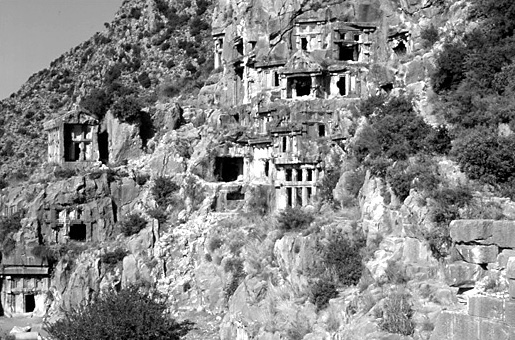 | 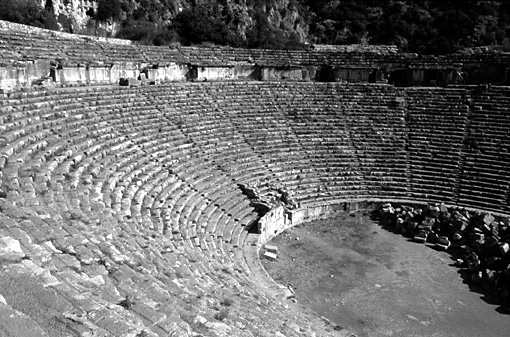 | 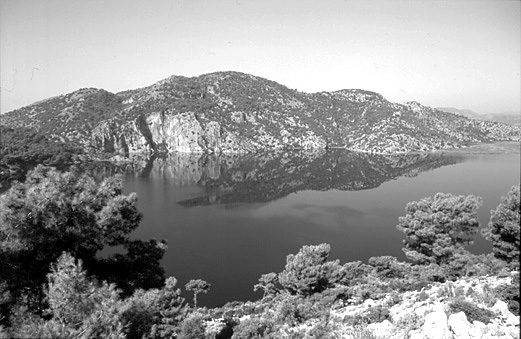 |
| Fig. 1. The necropolis carved in limestone at Myra during Lydian times | Fig. 2. Studies of weathering features on limestone constructions of known age, such as this Roman theatre at Myra, can provide insight into weathering rates and the potentially long period required for soils to reform in degraded karsts | Fig. 3. Karstic Kocagol Lake in southern Turkey. Special management measures are being implemented to improve the prospects for maintaining the quality and quantity of karst waters above and below ground, but the teeth are often blunt. |
There is no fundamental difference between Turkish and Tasmanian karst to suggest our karst soils are any less vulnerable - the situation is more severe in Turkey mainly because of the longer history of soil disturbance. We need to take the management of our own karst soils very seriously.
On a more cheerful note, I was somewhat stunned to learn that Patara was the birthplace of St Nicholas, and I later visited the now-excavated remains of his church in nearby Myra. I never did find out what his prompted his subsequent move to the North Pole, though having come from such a hot climate I can well understand his need to wear a fluffy red coat to keep warm in his new abode.
Groundwater
The management of karst groundwater is a major issue (Figure 3). Ancient cities prospered where karst water resources were available, and the demise of some of them appears to have been related to limitations of supply (not withstanding numerous Roman aqueducts) or declines in water quality, sometimes related to siltation problems. Today at the city of Anatalya large volumes of springwater are exploited for hydro-electricity, irrigation and domestic use, but maintaining acceptable quality poses some problems, notably in relation to bacteriological contamination. Anti-pollution regulations remain inadequate due to excessive discretionary provisions and a lack of input from groundwater specialists. Hopefully we won't wait until things get as bad in Tasmania before we act. Where groundwater quality remains sufficiently high, karst springs are important commercial assets both for bottled water (as locally in Tasmania) and for pumping to tanker-ships for export. Since many of these springs are in coastal settings over-pumping can lead to the contamination by the intrusion of salt water into the aquifer. Other problems with which we in Tasmania are becoming familiar are among those that have evolved into difficult issues in Turkey, including refuse dumping in sinkholes and faecal contamination of groundwater.
Forestry
I was able to view a little of the attractive forests in parts of the southern Taurus Mountains (Figures 4 & 5). Conifers predominate in plantation areas in those karst areas I visited, with eucalypt plantations generally restricted to better soils (especially alluvial soils) elsewhere. Conifer planting has been extensive on less degraded areas of the karst: growth appears to be slow and in those karst areas I visited tree-form is often poor. Land rehabilitation appears to predominate over commercial harvesting considerations in many karst areas and such logging as occurs is selective. Wildfire had caused considerable damage in some areas within the past two years, the fire risk heightened by forest dryness caused by the loss of most water underground into the karst.
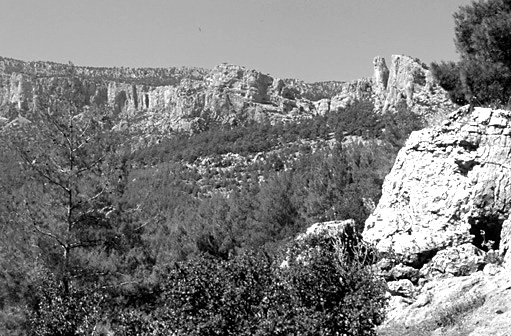 | 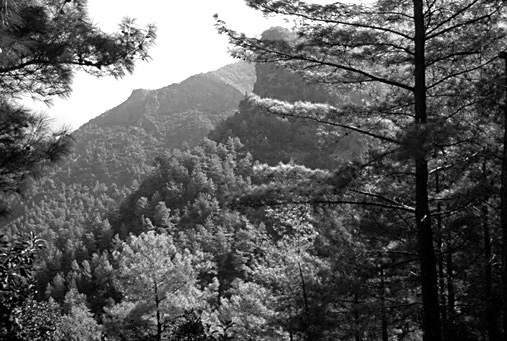 | 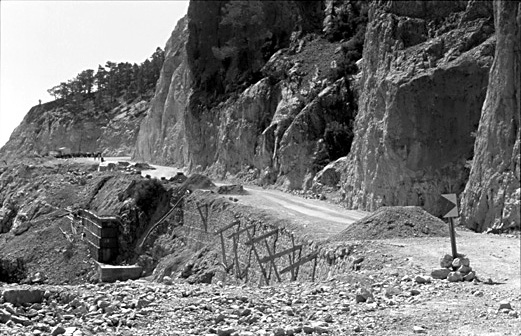 |  |
| Fig. 4. Karst forests in the Ermenek Valley | Fig. 5. Forest near the privately managed Dim Cave | Fig. 6. Landslide problems on a major road constructed through karst towards a proposed hydro-electric development site in southern Turkey. The landslide has occurred at a fault between two limestone units. | Fig. 7. The spectacular limestone gorge of Saklikent; the river emerges from large springs. |
Other management considerations
Steep karst hills and mountains can pose difficulties for communications and other infrastructure (Figure 6). But while the surface karst can pose difficulties, some of it is also valued for its scenic and recreational qualities, much more so than in Tasmania. The climate plays a role in this - cool pavilions constructed over emerging springs in the shelter of groups of trees provide relief from the heat for locals and tourists alike. Karst gorges such as that at Saklikent (Figure 7) are important tourist sites, and caves have been a focus of human activity since pre-Roman times. I visited two tourist caves run by government. The more highly decorated has become severely degraded due to the behaviour of unmanaged visitors, a lack of track cleaning and severe lampenflora infestations caused by the heat and the light from artificial lights that have been left burning continuously. Discolouration has been caused by the artificially stimulated algal growth and physical damage by acids produced by the algae has taken a heavy toll on speleothems (stalactites etc.).
One of the caves is named Asthma Cave, reflecting the belief widespread in parts of Europe that cave atmospheres can be therapeutically beneficial for sufferers from some respiratory complaints - various underground respiratory clinics exist in parts of Europe, where there is a well established underground branch of medicine, termed speleotherapy. But this cave is also known as the Wishing Cave which is not so good for the health of the cave, because the customary wishing ceremony entails throwing dollops of mud at the nearest cave wall or speleothem - there are minor mud quarries beside the tracks complete with buckets of water, though I left none the wiser as to whether they were to assist in mixing the mud or for making ones hands dirtier by washing them afterwards.
But I also visited another cave opened only two years ago by a group of seven retired geomorphologists and geologists under licence from the Forestry Department. The first Turkish cave to be privately developed, the tour is self-guided but with staff maintaining a watchful presence underground, and very conscious of issues such as lampenflora. The owners are knowledgable and keen to get things right - I was quizzed at length by one owner regarding a number of technical cave management issues. The operation provides employment for 15 local people.
Perceptions of Tasmanian karst
My Turkish perambulations were undertaken in the company of a number of karst managers from various parts of the world, so I was able to make various useful new contacts and renew some old ones. I found some of the work currently occurring in China particularly interesting because its focus is on the conservation and rehabilitation of environmental diversity in karst in a broad sense, rather than just being narrowly discipline-focused. My Chinese colleagues expressed considerable interest in the approach of the Forest Practices Board in Tasmania, indeed the senior Chinese karst luminary tried his best to talk me into running an international karst symposium in Tasmania in 2004 - a suggestion that was met with considerable enthusiasm by some others keen to come, but a task of greater magnitude than we have the time, resources and personnel available to take on.
So why all this interest in Tasmania's karst? Perhaps because it is the antithesis to what we were seeing and the situation so many karst managers overseas have to deal with. The significance and hitherto relatively intact nature of our karst seemed surprisingly well known, and it is clear Tasmania is perceived to be among the leaders in some aspects of karst forest management. I was encouraged that while others seem to be advocating action, we have already taken some of the necessary first steps. But on the other hand, I was also questioned about other forms of karst land use in Tasmania, principally agriculture, and why we were not taking a more integrated approach - in my view the essential next step. And I was also asked about the current conservation status of some important karst heritage sites, and why such places as the Croesus Cave area and Junee system, well known internationally from the scientific literature, remain unreserved. A very good question.
* Dr. Kevin Kiernan is a Fellow of ACKMA and Senior Geomorphologist, Forest Practices Board, Tasmania. This article originally appeared in the FPB publication "Forest Practice News" Vol. 4. No 2. and is re-printed with permission.